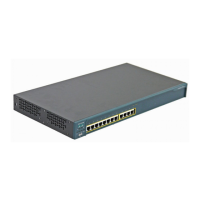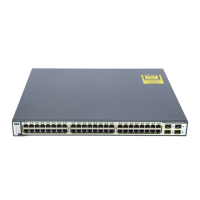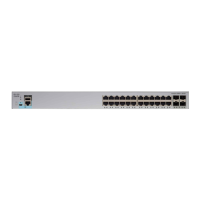9-8
Catalyst 6500 Series Switch Software Configuration Guide—Release 8.7
OL-8978-04
Chapter 9 Configuring Spanning-Tree PortFast, UplinkFast, BackboneFast, and Loop Guard
Configuring PortFast on the Switch
• If your network has a type-inconsistent port or a PVID-inconsistent port, all BPDUs are dropped
until the misconfiguration is corrected. The port transitions out of the inconsistent state after the
message age expires. Loop guard ignores the message age expiration on type-inconsistent ports and
PVID-inconsistent ports. If the port is already blocked by loop guard, misconfigured BPDUs that
are received on the port make loop guard recover, but the port is moved into the type-inconsistent
state or PVID-inconsistent state.
• In high-availability switch configurations, if a port is put into the blocked state by loop guard, it
remains blocked even after a switchover to the redundant supervisor engine. The newly activated
supervisor engine recovers the port only after receiving a BPDU on that port.
• Loop guard uses the ports known to spanning tree. Loop guard can take advantage of logical ports
that are provided by the Port Aggregation Protocol (PAgP). However, to form a channel, all the
physical ports that are grouped in the channel must have compatible configurations. PAgP enforces
uniform configurations of root guard or loop guard on all the physical ports to form a channel.
These caveats apply to loop guard:
–
Spanning tree always chooses the first operational port in the channel to send the BPDUs. If that
link becomes unidirectional, loop guard blocks the channel, even if other links in the channel
are functioning properly.
–
If a set of ports that are already blocked by loop guard are grouped together to form a channel,
spanning tree loses all the state information for those ports and the new channel port may obtain
the forwarding state with a designated role.
–
If a channel is blocked by loop guard and the channel breaks, spanning tree loses all the state
information. The individual physical ports may obtain the forwarding state with the designated
role, even if one or more of the links that formed the channel are unidirectional.
Note You can enable UniDirectional Link Detection (UDLD) to help isolate the link failure.
A loop may occur until UDLD detects the failure, but loop guard will not be able to
detect it.
• Loop guard has no effect on a disabled spanning tree instance or a VLAN.
Configuring PortFast on the Switch
These sections describe how to configure spanning-tree PortFast on the switch:
• Enabling PortFast on an Access Port, page 9-8
• Enabling Spanning-Tree PortFast on a Trunk Port, page 9-9
• Disabling PortFast, page 9-10
• Resetting PortFast, page 9-11
Enabling PortFast on an Access Port
Caution You can use PortFast to connect a single end station or a switch port to a switch port. If you enable
PortFast on a port that is connected to another Layer 2 device, such as a switch, you might create network
loops.
